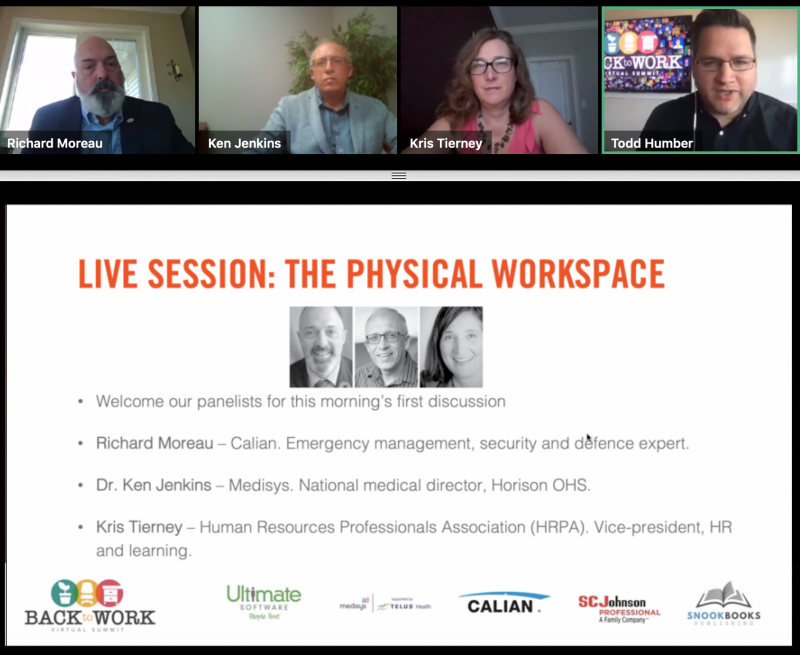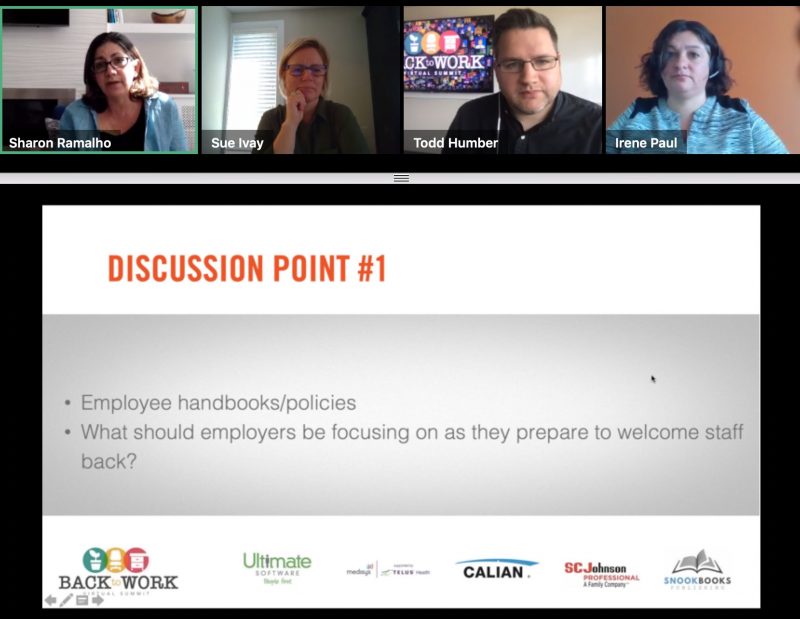

Features
Health & Safety
Mapping out a safe return to work
June 23, 2020
By
Marcel Vander Wier
 Following three months of intense efforts to mitigate the effects of the pandemic, Canada is slowly and surely returning to work. (nito/Adobe Stock)
Following three months of intense efforts to mitigate the effects of the pandemic, Canada is slowly and surely returning to work. (nito/Adobe Stock) With the initial challenges of COVID-19 closures mostly behind Canadian employers, the focus has now turned to reopening.
Following three months of intense efforts to mitigate the effects of the pandemic, Canada is slowly and surely returning to work.
On May 27, together with sister publication OHS Canada, Talent Canada hosted the Back to Work virtual summit in an effort to share best practices and policies for employers looking to reopen. Close to 500 business leaders attended.
Federal Labour Minister Filomena Tassi opened the event, encouraging employers to keep the faith while anticipating a “new normal.”
“The success of this project is knowing that we all share a common goal,” she said. “That is to reopen in a way that is safe for all Canadians, industry, labour and the general public.”
The event included two live panels featuring a variety of panellists and was moderated by Talent Canada publisher Todd Humber.
Preparing physical workspaces
In mid-March, COVID-19 shut down large parts of the Canadian economy and forced employers and employees to adjust how they work.
Essential and frontline services remained open with protections such as physical distancing and proper personal protective equipment (PPE) in place, said Richard Moreau, an emergency management, security and defence expert with Calian, a professional services organization in Ottawa.
Challenges did arise due to varying interprovincial standards, however, he said.
“Despite the fact that the federal government provided some guidelines, at the end of the day, it’s up to each jurisdiction to decide how they are going to proceed,” said Moreau.
“We quickly came to the conclusion that we couldn’t rely on each of the provincial plans — we needed to have our own to anchor our decisions on.”
Once completed, the plan was adjusted on a site-by-site basis, he said.
“In the end, our approach has been to bring back to work those who need to be back at work first, followed eventually by those who want and can return to work, and finally add some flexibility with adjusting to the new reality for those who can continue to work efficiently virtually and don’t need to re-enter the office space,” said Moreau.
“Our approach has been to go as fast as possible, but also as slow as required.”
Common areas, temperature screening
When office facilities are greenlighted to open, working alongside the building management on protections is advised, according to Kris Tierney, vice-president of HR and learning at the Human Resources Professionals Association (HRPA) in Toronto.
Landlords can assist by ensuring proper signage and protocol is in place in common building areas, she said.
“It’s easy for us to control our own worksite… (but) every movement of the tenants, of your workforce, of your employees needs to be considered in those common places.”
To properly protect workers, policy must be in place that takes into context the advice of the chief medical officer, said Dr. Ken Jenkins, national medical director of Horizon supported by Telus Health, based in Newfoundland.
“We have to get away from employees coming back to work when they’re sick,” he said. “Let’s face it — in the past, people would have a cold, even a flu, and would show up at work. Those days are over. We’re not going to be able to afford to have people presenting the risk of transmitting a virus to other workers.”
In terms of temperature screening, Jenkins advised policy that has employees screen themselves before they leave home, noting online assessment tools are available.
“If anybody screens negative and (doesn’t) have any particular high risk for this illness, they should wash their hands with a sanitizer and then proceed on to the office setting,” he said.
Temperature checks are an extra layer of protection, but Jenkins said the science doesn’t necessarily stand behind this type of testing.
For staff members who have tested positive for COVID-19, if they are asymptomatic after 14 days, they can safely return to work, he said.
“There are no requirements for test clearance for returning to work.”

(Screengrab/Back to Work Virtual Summit)
Lessons from essential businesses
Grocery stores and other essential businesses across Canada were the first to adopt proper health and safety protocols in the age of COVID-19, and employers in other markets would be wise to learn from them, said Tierney.
Plexiglas usage, directional signage and mandatory hand sanitizer upon entry are all helpful on-site protections that can be adapted in other work settings, she said.
In deployment of these tactics, communication is critical, though businesses must be able to back up their guidelines, said Tierney.
“You need to engage your supervisors, your managers to help with that,” she said. “You need everyone to really agree to and accept those new guidelines.”
Changing employee behaviours won’t necessarily be easy, said Jenkins.
“Leaders have to show up at this time,” he said. “Crisis periods are times when leaders come forward… The baton is being passed now. It’s going from leadership in politics and leadership in public health, and it’s being passed to business leaders as we get the economy restarted.”
Senior leaders need to “seize the moment” and reinforce important public health messaging, said Jenkins.
“Take time to clarify roles and responsibilities,” he said. “Try to rebuild your stamina, flexibility and strength in your workforce, because there’s deconditioning that has gone on over this time.”
“A lack of ramp up is potentially problematic, because it can result in dysfunctional behaviour… and worst case, it can lead to mishaps and injuries.”
HR and policy changes
Ensuring a revamped business plan adjusted to the “new normal” is in place is a solid starting point for Canadian employers, according to Sharon Ramalho, a Toronto-based consultant and former chief people officer at McDonald’s.
But when it comes to people-related policy, health and safety is priority No. 1, she said.
“Business leaders, HR leaders, we’ve got to get that right, because that impacts people’s mental health. It impacts the productivity that will then take place. And it impacts customers and clients that employees will be interacting with moving forward.”
While government policy will need to be abided by, talking to employees to understand their unique concerns is best practice, said Ramalho.
Adjusting benefits plans to potentially include more personal days, mental health supports and paid sick leave are further considerations, she said.
“People want to know that they’re going to be safe.”

(Screengrab/Back to Work Virtual Summit)
Spotlight on payroll
An extra wrinkle in the COVID-19 shutdowns was the rapid emergence of emergency government wage subsidies, said Irene Paul, a compliance advisor at Ultimate Software in Montreal.
“In general, when a measure is announced… there is months that go between the announcement and when it actually becomes effective,” she said. “This hasn’t been the case with all the measures that are related to COVID-19.”
As of late May, there has been at least 115 changes impacting HR and payroll as a result of government wage subsidies, according to Paul.
“These things needed to happen because funds had to go out to struggling businesses so that they could keep paying their employees,” she said. “We didn’t have the opportunity to iron all of the details out and make sure that everything was clear.”
In terms of the Canadian Emergency Response Benefit (CERB), it’s important to note that payments to employees don’t concern the employer — it is a direct transaction between individuals and the Canada Revenue Agency, said Paul.
Remuneration boosts for essential workers and those on the front lines deserve applause, said Ramalho.
“That signals to employees that we value you; we value your contributions; we appreciate the work you are doing,” she said. “What more can you do for employees to really retain the talent that you invested so much time in nurturing and developing?”
Seizing new opportunities
COVID-19 shutdowns were disruptive to all Canadians, said Sue Ivay, chief human resources officer at Calian.
“Once we can process that fact, I think it’s such a wonderful opportunity for leaders to really get to know their people,” she said. “It’s such a beautiful opportunity for individual managers to really get their team members to engage, to get to know them better than you ever could have in an office setting… to really engage with your teams on a much deeper level.”
It is possible to consider the pandemic as an “exciting time” for workplace change, said Ivay.
“The opportunity for what this is going to look like next month, six months, 18 months, 24 months from now, it creates a whole other level of opportunity for all of us,” she said.
“This is the Internet coming in and disrupting video stores.”
Print this page